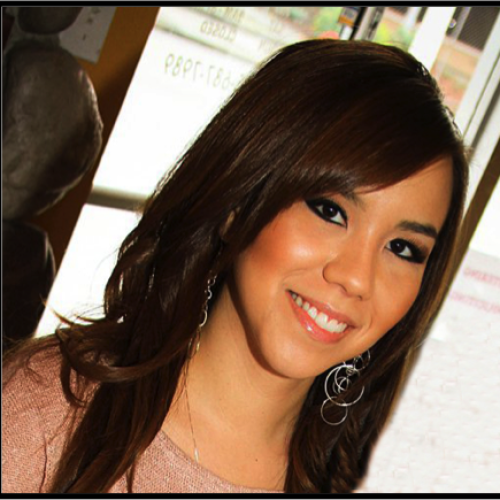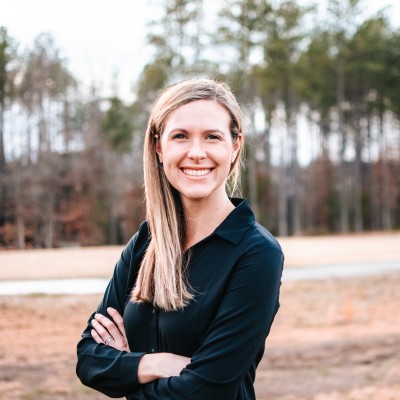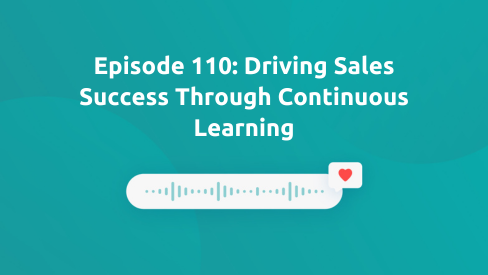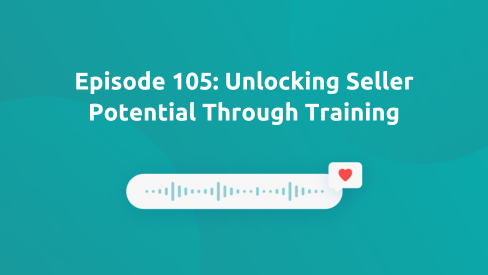Organizations that are highly effective at managing ongoing training report win rate improvements of 10 percentage points, according to research from Sales Enablement PRO. So, what does “highly effective” training look like?
Shawnna Sumaoang: Hi and welcome to the Win Win Podcast. I’m your host, Shawnna Sumaoang. Join us as we dive into changing trends in the workplace and how to navigate them successfully. Here to discuss this topic is Stephanie Aylward, the manager of revenue enablement at Fastly. Thanks for joining, Stephanie! I’d love for you to tell us about yourself, your background, and your role.
Stephanie Aylward: I manage the revenue enablement team at Fastly. If you aren’t familiar with Fastly, we serve about 20% of all internet traffic. For the revenue enablement team, we are a mighty team of two, and we support about 250 reps across sales, SDR, account management, and sales engineering. I’ve formally been in the enablement space for about four years, and prior to that, I spent about 10 years in various sales and sales management roles.
SS: I’m excited to have you join us here today. Now, you actually spoke at our annual conference, Spark ‘22, last year in the fall on a panel around developing future-focused training programs. Stephanie, I’d love to hear from you directly for our audience. In your opinion, what does it mean to have training that is built for the future?
SA: I think it really takes into consideration a global workforce and a variety of learning styles. With traditional live “training”, it’s hard to tailor it to different types of learners if you’re talking to someone, and with a global workforce, it’s hard to find presenters that can speak for all the time zones, plus not everyone can join at certain times because they may have customer meetings. From my perspective, training for the future would be self-paced, so a rep can absorb it on their own time. It would have a variety of different learning mediums, like texts, short videos, knowledge checks, Gong snippets, and infographics, and in a perfect world, it would have manager reinforcement, like a rubric for a stand and deliver.
SS: I love those. I think those are really straightforward. Now, from your perspective and your experience, what does good sales training look like?
SA: I think it really looks like everything I mentioned above, which is what we’re striving for. We are not perfect. It’s definitely a journey, but that is really what we are striving for. The only thing I’d add to what I said is that like when you do it, it shouldn’t just be one and done. After launch, you have to take careful consideration of how you’re going to fold it into ever-boarding so that content that you work so hard to curate does not get buried in a course. You want it to be extracted and to be very findable later so that existing reps can go back to it.
You also need to consider how it gets folded into onboarding and if it gets folded into onboarding. With everything I mentioned, there’s also just being careful that you’re not including items like long videos, names, pricing, or anything that can get dated quickly because that can be difficult to maintain.
SS: Absolutely. You guys leverage, at Fastly, Highspot Training, and Coaching. I’d love to understand how you leveraged that to implement what good looks like as you’ve just described it.
SA: First I want to say I’m very lucky to have someone on my team with a background in instructional design. She’s very creative and very good at incorporating a lot of those items that I mentioned. She also has a background in teaching, so really understands the importance of catering to all different kinds of learners.
She uses Training and Coaching, and I can kind of give you an example if that helps. We purchased a security company a few years ago called Signal Sciences. At that time, none of our reps had a background in selling security, so we had to bring them all up to speed on the security landscape, our buyers, how the solution solved buyers’ problems, and a high-level elevator pitch. We used Training and Coaching for that. That was our first really big initiative that we used it for because it really allowed reps to absorb new information on their own time in their own way, and then kind of have a capstone at the end where they were delivering their pitch or their manager and getting signed off. It was an enormous cross-functional project and we did all of that with Training and Coaching.
SS: That is a very impressive example. Now, from your experience, how can training boost productivity and what are some of the best practices that you’ve really found success with?
SA: I think from my perspective in terms of boosting productivity, training can absolutely shorten the ramp of achieving a really big behavior change. Going back to my Signal Sciences example, we have something completely new, like how are we going to achieve this big behavior change of getting reps to sell security? When we do have those big initiatives, training can close the time it takes to achieve that big shift in the sales organization, and from my experience, to do it well, you really have to connect all the dots for reps.
So why are we doing this? What are our customers’ problems? How does this solution address them? But, also, by the way, here are actionable things you can use. Here are email templates, and talk tracks, here’s external-facing collateral you can use. In some sense, it can’t just be training, it’s more of let’s package everything all together and just hand them a toolkit on a silver platter that they can use to get up and running quickly and put all of this education into action. I think that is, collectively, what can boost productivity.
SS: I love that. Now, one best practice that you also mentioned in your panel discussion is the use of a readiness council to gather feedback on training. Can you share with our audience more about what this council is and how it’s helped you optimize your training?
SA: Every quarter I have a small group of about five sellers, SDRs, AMs, and SEs, and I lean on them to help us build content or to review a dry run of training before it goes live. While I mentioned that Training and Coaching are ideally what we use for everything, we still do some of our training live if it’s a time-sensitive initiative.
For example, for training we’re working on right now for a new product line, we use the Sales Readiness Council to give input on the training outline before our subject matter experts build it. We also had them sit in on the dry run and interject with questions, comments, concerns, suggestions, and things like that as the presenters went through it. We purposefully select people who like to participate in these big company initiatives and people that will speak up with candid feedback, because we don’t want to just hear, oh, you know, oh, this is great, we love it. We really are looking for constructive criticism so that we can fine-tune the training, we can make sure we didn’t miss anything, and ultimately deliver a better outcome.
In some cases, we’ve done the dry run and it’s gone a little bit rogue and it was in those moments that we realized we needed to slow down and revisit the outline and what we were trying to achieve. It has been effective in either fine-tuning something that’s almost there or in some cases making us rethink how we approach something.
SS: In addition to the feedback that you’re gathering, how else do you measure the success of training at your organization and how do you leverage Highspot to assess impact?
SA: At the moment we are really big on survey feedback and completion. We use SurveyMonkey for surveys. We have that embedded into the Highspot Training and Coaching learning paths, and then we leverage Highspot to track completion. Where we’re headed for our next phase is we want to be looking at the same pane of glass that sales are looking at in order to drive decisions on what we focus on. Ideally use the exact same metrics they’d be using, like opportunities created, pipeline created, conversion rate, closed-won deals by product line, and things like that. As a company, we are still young so I know our analytics folks are working hard to build that dashboard, and once we have it, we are excited to be able to leverage that along with many other teams at Fastly.
SS: Well that sounds like fantastic progress. Now, what are some of the business results that you’ve achieved through the training programs that you’ve created and delivered?
SA: If I take a step back, I think it’s sometimes hard in our space to make a direct correlation between training programs only and business results, but that said, and from my experience, I think when your company has a big strategic initiative and everyone is all in on it, so you have the backing of your CRO, marketing is involved, sales operations is involved in many different functions, you can have an incredible impact. If I go back to that security example and the acquisition, when we first bought that company, everyone doubled down. All of those teams that I mentioned and then all of their efforts combined with our enablement efforts I think is what really produces very effective business results. Now the security side of our business is doing very well post-acquisition.
A more recent example is we are currently rolling out force management, which is our sales methodology. Our sales cycles are long. We are less than a year in, so it’s a little early to report on business results, but we are getting good feedback and traction there.
SS: Those are still very impressive results. Now to close, I’d love to learn more about your predictions for the future of training at your organization. How will your training programs evolve in the next year, and how do you envision leveraging Highspot training and coaching throughout that evolution?
SA: Great question. I think for us it’s going to become more about ‘less is more’ which I think ties nicely to our current economic climate and the current state of the tech industry. Our company is evolving rapidly, so we have many initiatives and there are many requests to get in front of sales. This year we’re really going to force our sales leaders to prioritize what gets attention and what doesn’t so that we can spend 80% of our time on the 20% of things that matter and then we’ll actually move the needle.
That would be what my prediction is. As teams get smaller you really do have to be very careful about what you say yes to and what you say no to, because that way when you do say yes to the most important things, you can really double down and create programs that mirror what I spoke about earlier of what we’re striving for where we are using Training and Coaching, we’re including tons of different learning mediums. We’re careful not to include content that could get dated and really build out like very powerful programs versus if when you try to do it all, you have to be light in many areas and you can’t make as big of an impact.
SS: Thank you so much for joining us, Stephanie. I really appreciate you sharing your insights.
SA: Thank you.
SS: To our audience, thanks for listening to this episode of the Win Win podcast. Be sure to tune in next time for more insights on how you can maximize enablement success with Highspot.



